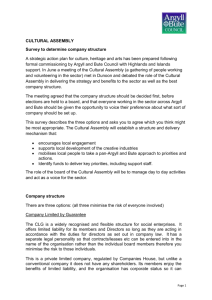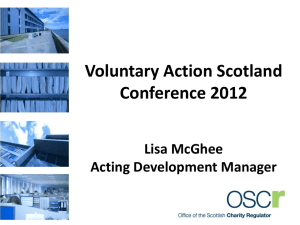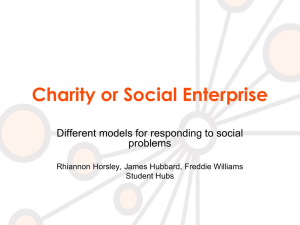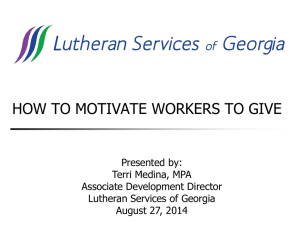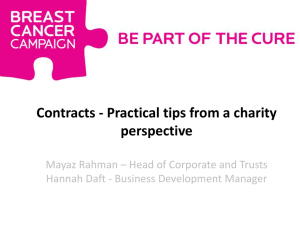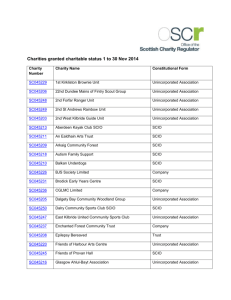SCIOs and conversions_Morton Fraser
advertisement
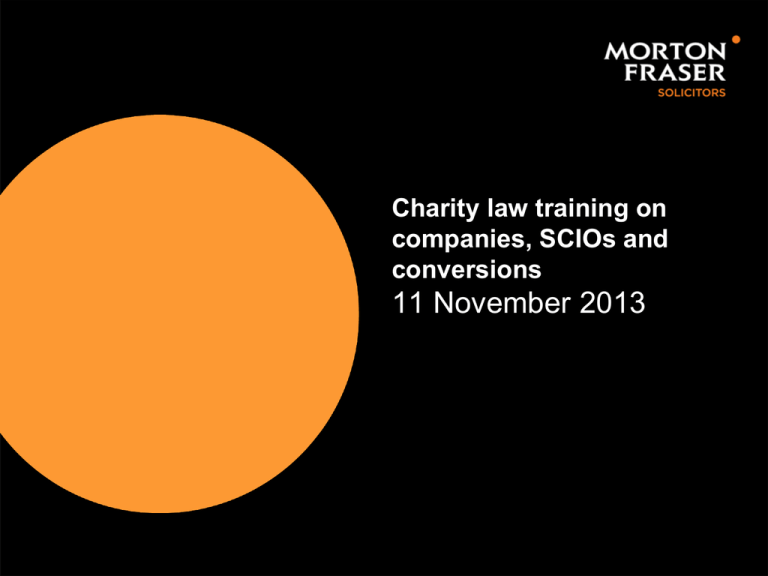
Charity law training on companies, SCIOs and conversions 11 November 2013 Summary of today’s format • 2.00pm – 2.15pm Introductions • 2.15pm – 2.45pm Presentation on incorporation • 2.45pm – 3.30pm Case Study • 3.30pm - 4.00pm Questions and answers/discussion International Development Small Grants Programme • £500,000 per year 2014-2017 • Types of grant:• project (max 60k over 3 years) • feasibility (max 10k over one year) • capacity building (max 10k over one year) • Eligibility • annual turnover of less than £150,000 • ‘Scottish based organisation’ • must be established as ‘not for profit’ (CICs??) • must constitute a ‘legal person’ i.e. be incorporated • been in existence for at least 12 months • Deadline for applications: 29 November 2013 • SG will accept applications from organisations ‘who will be incorporated by 1 March 2014’. • ‘In subsequent years, only organisations which are already incorporated will be eligible to apply’. Incorporated structures Incorporated v unincorporated •Unincorporated – low cost, little regulation (unless a charity), no registration but no separate legal personality so individuals can be personally liable •If the organisation has employees, owns or leases property, or is raising finance…generally taking on risk, then it may make sense to use an incorporated vehicle – this is because – in most cases – incorporation and limited liability will provide some degree of protection if things go wrong. Incorporated structures • Companies • Company limited by guarantee • Community interest company (‘CIC’) • Scottish Charitable Incorporated Organisation (‘SCIO’) Common features of incorporated options • • Two tier – ‘managers’ and ‘members’ • Directors/ trustees • Members Constitution which sets out • what the organisation can do • who its members are • who its directors are/how they are appointed • powers and responsibilities Company structure • • • • • Most common form of vehicle used – tried and tested. Considered to be flexible. Company limited by guarantee – each member gives a guarantee that he will pay a certain sum to the company in the event that the company is wound up. A guarantee company cannot pay dividends to its members. Separate legal entity - so can enter into contracts in its own name; sue and be sued etc. Governing document – the articles of association (the ‘constitution’). Objects clause of the articles states what the company can do – its purpose. Social mission can be provided for here (or not). Companies contd. • • • Regulation – Registrar of Companies • Annual filing requirements (accounts; Annual Return) • Event driven requirements (change of articles; resignation of directors) Limited liability – for the benefit of the members, not the directors. Directors’ duties Codified in Companies Act 2006 • To act within the powers given in the company’s constitution • Promote the success of the company (includes obligation to consider long term consequences of decisions; interests of employees etc etc) • Exercise independent judgement • Exercise reasonable skill, care and diligence • Avoid conflicts of interest • Don’t accept benefits from third parties • Declare interests Summary – act fairly, honestly and in the interests of the company Pros and cons of being a company Pros • tried and tested • funders comfortable with this kind of vehicle • limited liability • directors’ duties Cons • need to comply with Companies Act 2006 and other legislation • dual registration and regulation for charitable companies • reporting requirements • publicity (e.g. accounts are public documents) • directors’ duties Community interest company (CIC) • • • • • • • • • • • Introduced 2005 to address the lack of an appropriate legal vehicle for noncharitable social enterprises. Just like a company (shares/guarantee), with some special features. A CIC must have a ‘social objective’ or rather must meet the ‘community interest test’ – this means that the CIC regulator must be satisfied that its purposes could be regarded by a reasonable person as being for the benefit of the community. And it must also have an ‘asset lock’ – means the CIC cannot generally transfer its business or assets for less than full market value or to another asset locked body. Also protection in the event that the CIC is wound up. Can be attractive to funders. CIC with shares can pay dividends to members – but there is a cap on how much can be paid out. Surplus assets must be recycled into CIC or to another charity. 20% of paid up value. Max 35% distributable profits. CIC without a share capital cannot pay dividends. Regulated by the CIC Regulator (effectively, Companies House). Compliance with company law and CIC Regulations. Annual accounts and Annual Community Interest Company Report A CIC cannot be a charity. Useful halfway house for social enterprise where charitable status not available. Pros and cons of being a CIC Pros • • • • • • • • members enjoy limited liability does not need to be (indeed cannot be) recognised as a charity and is therefore subject to less regulation can act more commercially than charities (but remember grant criteria…?) not the same tax benefits as a charity regulation by CIC regulator allows community benefit/ private gain allows equity investment but caps on returns (for CICs with shares) directors can all be paid Cons • its assets are subject to a ‘asset lock’ which means that all surplus assets must be retained for use for the company’s social or community purpose, and if transferred out of a CIC, the transfer must either (a) be made for full consideration; (b) generally be made to another asset locked body (a CIC or charity); or (c) be otherwise made for the benefit of the community • it cannot be a charity • it does not benefit from as favourable tax treatment as that applied to charities SCIO “A new legal form which will allow Scottish charities to incorporate without having to become a company.” • Long time coming. Discussions started in 1996. Came into force 1 April 2011. • The main purpose of a SCIO is to give a charity the benefits and legal protection of an incorporated body - but without the perceived disadvantages associated with being a limited company or some other type of incorporated body. • The SCIO is a form exclusive to Scotland, and will be subject to Scottish Charities legislation and regulation by OSCR (not the Registrar of Companies). • A SCIO must meet the charity test. • A company, charity or a CIC will be able to convert to a SCIO. • Not to be confused with CIOs – the English equivalent. Where is the law? • • • • The Charity and Trustee Investment (Scotland) Act 2005 • sections 49 to 64 – contain authority for Scottish Ministers to make further provisions by regulation… The Scottish Charitable Incorporated Organisations Regulations 2011 The Scottish Charitable Incorporated Organisations (Removal from Register and Dissolution) Regulations 2011 OSCR guidance – ‘SCIOs: A Guide’ SCIO minimum requirements • Section 49 - must:• be a charity • have a constitution (which must include certain things) • have a principal office in Scotland • have at least 2 members (individuals) • Section 50 - constitution must:• state name and purposes • provide for:• who is eligible for membership and how to become a member • for the appointment of 3 or more persons to be trustees, and their eligibility • such other matters as may be required by the Regulations • Section 50(5) - subject to anything in its constitution, a SCIO has the power to do anything which is calculated to “further its purposes or is conducive or incidental to doing so”. Constitution Minimum requirements Regulations impose additional requirements on contents of constitution:• restriction on powers • organisational structure • procedural rules including:• how meetings are convened • records of meetings • quorum • voting rights of members and trustees • how resolutions are passed • processes for withdrawal and removal of members and trustees • Restrictions upon remuneration oftrustees which go beyond the restrictions in the Act • procedures for dealing with conflicts • how surplus assets must be used on winding up or dissolution Other points to note • • • Some of the duties which apply to trustees of a charity will apply to members of a SCIO e.g. must act in interests of SCIO and with care and diligence of person managing the affairs of another person. Breach = misconduct in the administration of the SCIO. If SCIO ceases to be a charity, then it ceases to be a SCIO. What does this mean in practice? Winding up regulations provide for:• solvent winding up – like a ‘striking off’ of a company. Surplus assets must be transferred to another charitable organisation (in terms of SCIO’s constitution). • insolvent winding up – treated like the bankruptcy of a person. OSCR to refer such an application to Accountant in Bankruptcy Pros and cons of being a SCIO Pros • separate legal personality • limited liability • only registered with OSCR • tax reliefs Cons • uncertainty e.g. what happens on a winding up? • members have equivalent of some director’s duties? • needs to be a charity • other charity rules apply • unfamiliar, particularly abroad? Conversions: practicalities and legal issues Conversion = change in legal form • Essentially, conversion is a change in legal form, so could affect:• existing contracts • employees/pensions • property (vehicles; bricks and mortar) • funding (bank & grants) • …need to do due diligence • Where a charity – is it in the best interests of the charity to convert? Conversion: process • Conversion of unincorp to:• SCIO • CIC • company limited by guarantee • Each has different process. Case study: conversion of charitable unincorporated association to a SCIO • Check existing constitution to confirm that organisation has the power to convert to another legal form. • Conduct "due diligence" on existing organisation (e.g. identifying contracts, employees and assets and whether any third parties such as lenders will need to consent to the change). • Draft up legal documents including new constitution (what works/doesn’t work with existing constitution?), OSCR forms and Transfer Agreement. • Think about practicalities e.g. will bank insist on new accounts? • Have members approve the "conversion" [subject to OSCR's consent]. This is usually done at a meeting of the members, so bear in mind notice periods. • Assuming members approve the conversion, seek OSCR consent to changes ("Stage 1 consent"). Amend and finalise legal documentation accordingly. • Assuming OSCR issues "Stage 1" consent, submit "Stage 2" consent request to OSCR. • Assuming OSCR issues "Stage 2" consent, execute Transfer Agreement etc. • Notify OSCR that conversion has taken place. Deal with practical matters such as changing bank accounts, notifying suppliers and parents etc. • Don’t forget to notify HMRC of change • Update website, letterhead etc Further information Contact details: adrian.bell@morton-fraser.com lauren.scott@morton-fraser.com •www.morton-fraser.com •www.oscr.org.uk
